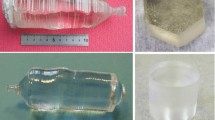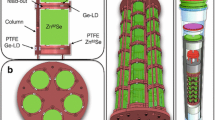Abstract
In the view of exploring the inverted hierarchy region future experiments investigating the neutrinoless double beta decay have to demand for detectors with excellent energy resolution and zero background in the energy region of interest. Cryogenic scintillating bolometers are very suitable detectors for this task since they provide particle discrimination: the simultaneous detection of the phonon and light signal allows us to identify the interacting type of particle and thus guarantees a suppression of \(\alpha \)-induced backgrounds, the key-issue for next-generation tonne-scale bolometric experiments. The LUCIFER project aims at running the first array of enriched scintillating Zn\(^{\text {82}}\)Se bolometers (total mass of about 8kg of \(^{\text {82}}\)Se) with a background level as low as 10\(^{\text {--3}}\) counts/(keV kg y) in the energy region of interest. The main effort is currently focused on the finalization of the crystal growth procedure in order to achieve high quality Zn\(^{\text {82}}\)Se crystals both in terms of radiopurity and bolometric properties. We present results from tests of such crystals operated at mK temperatures which demonstrate the excellent background rejection capabilities of this detection approach towards a background-free demonstrator experiment. Besides, the high purity of the enriched \(^{\text {82}}\)Se material allows us to establish the most stringent limits on the half-life of the double beta decay of \(^{\text {82}}\)Se on excited levels.

Similar content being viewed by others
Notes
Since gaseous SeF\(_{\text {6}}\) can be produced, the enrichment procedure of choice for selenium is centrifugal enrichment, a well established and the most cost-efficient enrichment technology.
References
F.T. Avignone, S.R. Elliott, J. Engel, Rev. Mod. Phys. 80, 481 (2008)
E. Majorana, Il Nuovo Cimento 14, 171 (1937)
L. Cardani et al., JINST 7, P01020 (2012)
D.R. Artusa et al., Eur. Phys. J. C 74, 2956 (2014)
A.S. Barabash, Nucl. Phys. A 935, 52 (2015)
E. Andreotti et al., Astropart. Phys. 34, 822–831 (2011)
C. Arnaboldi et al., Nucl. Instrum. Meth. A 518, 775–798 (2004)
F. Alessandria et al., Astropart. Phys. 45, 13–22 (2013)
M. Clemenza et al., Eur. Phys. J. C 71, 1805 (2011)
C. Bucci et al., Eur. Phys. J. C 2, 155–168 (2009)
D.R. Artusa et al., Eur. Phys. J. C 74, 3096 (2014)
G. Angloher et al., Eur. Phys. J. C 72, 1971 (2012)
G. Angloher et al., Eur. Phys. J. C 74, 3184 (2014)
CUPID interest group, arXiv:1504.03599 (2015)
CUPID interest group, arXiv:1504.0361 (2015)
M. Ambrosio et al., Phys. Rev. D 52, 3793 (1995)
D. Lincoln et al., Phys. Rev. Lett. 110, 012501 (2010)
M. Berglund, M.E. Wieser, Pure Appl. Chem. 83, 397–410 (2011)
J.W. Beemann et al., Adv. High Energy Phys. 2013, 237973 (2013). doi:10.1155/2013/237973
C. Arnaboldi et al., Astropart. Phys. 34, 344 (2011)
J.W. Beemann et al., J. Instrum. 8, P05021 (2013)
I. Dafinei, J. Cryst. Growth 393, 13–17 (2014)
V. Ryzhikov et al., J. Cryst. Growth 364, 111–117 (2013)
T.O. Niinikoski et al., Europhys. Lett. 1, 499 (1986)
J.W. Beemann et al., arXiv:1508.01709 (2015), submitted to journal
G. Heusser et al., Radioactiv. Environm. 8, 495–510 (2006)
J. Suhonen et al., Z. Phys. A 358, 297–301 (1997)
R. Arnold et al., Nucl. Phys. A 636, 209–223 (1998)
Author information
Authors and Affiliations
Corresponding author
Rights and permissions
About this article
Cite this article
Beeman, J.W., Bellini, F., Benetti, P. et al. The LUCIFER Project: Achievements and Near Future Prospects. J Low Temp Phys 184, 852–858 (2016). https://doi.org/10.1007/s10909-015-1423-6
Received:
Accepted:
Published:
Issue Date:
DOI: https://doi.org/10.1007/s10909-015-1423-6




